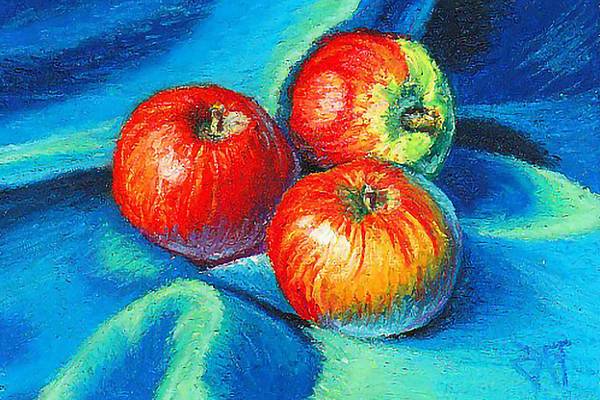By James V.
Can you use oil pastels on fabric? You can use oil pastels on fabric but you may not get the great look that you get by using regular oil sticks. It seems that oil pastels do not permanently dry so dust and grime can attach themselves to the oil pastels and ruin your creative expression.
What Are Oil Pastels?

If you are not an artist and have never used this color option before, it pays to learn what they are before you try to use them. Knowing a little bit about them helps you create better drawings and helps you preserve them a little better.
Oil pastels are a solid oil paint but not traditional paint. They are applied like you would use children’s crayons. One company uses pigment, paraffin, and mineral oil to make their brand of oil pastels.
You can prime your fabric by brushing on a layer of a medium that will dry clear or transparent. That will let you see any design you already drew when you are about to use the oil pastels.
Can You Use Oil Pastels On Fabric?
Yes, you can and some people have had some very excellent results especially after they heat set their artwork. So far, there doesn’t seem to be a fabric that you can’t use as one artist used a silky fabric in her sewing stash to create her work of art.
Also, you can try to use denim material but you may have to wait weeks before the oil pastels dry to the point where you can heat set them. The good thing about using oil pastels is that they are not as messy as some other fabric painting options.
If you want a comparison to understand what oil pastels are like, think lipsticks. Both the pastels and cosmetics are closely related and do not fully dry. That makes them prone to solvents and smudges.
The alternative to using oil pastels, if you want the artwork to fully dry, is to use an oil stick made with linseed oil instead of mineral oil.

It does to a point. The main reason many people may not use oil pastels on fabrics is that you cannot use a fixative like you can when you use paper as your canvas. It is very difficult to set oil pastels once it is placed on clothing material.
That lack of drying and fixing means you have to be careful if you want to frame your artwork and place it on a wall. The oil pastel will smudge if the glass is placed too close to the colors.
Oil pastels are easy to mix together if you are not afraid of getting your hands dirty. That makes them easy to work with and better for beginners to use than other paints or fabric applications.
If you make a mistake using this option of coloring your fabrics, you can always use a sharp knife or razor blade to scrape away your mistake and paint over it. Even if you could use a fixative to protect your painted fabric, it is said to be a short term solution and not a long term one.
Are Oil Pastels Permanent On Fabric?
Unfortunately, no they are not. That is when the oil pastels are made from mineral oil. This oil version is known as a non-drying oil. Once you paint the oil pastel made from this oil on fabric, do not expect it to last in its original final form.
Washing your fabric even after heat setting will not produce desirable results. That is if you can heat set the paint properly. Another aspect you should know about is that oil pastels tend to degrade the fabric over time if applied directly to the material.
Since oil pastels do not dry permanently on fabric or other canvas material, it is difficult to set them and get them to remain in their original design. Expect the color to smudge easily.
Also, you have to be careful what other materials you let get close to your clothing as solvents will remove your hard work in a second after contact. If you want to develop your artistic talent this may be a good option to practice and see what areas you can improve on.
But if you want everlasting art you may want to use a different art option and materials.
Heat Setting Oil Pastels On Fabric

The standard way for heat setting is to use heat from your iron and place a cloth over your artwork AFTER the oil or paint has dried. But since oil pastels never dry you may not be able to permanently heat set your work.
The other problem when using paint on or spray fixative or sealant is that the chemicals and liquid may alter your design as it goes on. An acrylic sealant may protect against smudging and allow you to do some light washing but it does harden and may crack on you.
Plus, to get a good seal on your artwork you have to use several layers of a fixative or sealant before the color is protected to some degree. Do a test first on a small area to see what kind of results you will get before spraying the sealant all over your fabric.
Tips for Using Oil Pastels On Fabric
While it is still possible to use oil pastels on fabric, do not assume that this material goes on fabric like fabric paint or acrylic paint will. here are some tips to guide your use of this alternative creative and artistic paint method:
1. Choose the right clothing – not every fabric will respond to oil pastels and since oil pastels do degrade material it is best to use inexpensive clothing. Also, you want to use fabrics that do not require a lot of washing.
2. Use the right surface – flat areas like the back or front of a shirt work best. The reason for that is that the oil pastels and the sealants create a hard inflexible surface. bending in them would be hard to do. Denim or similar hard surfaces are ideal fabrics to use when going beyond the front or the back of the clothing item.
3. Do the priming – the best primer to use would be water-based acrylic paint. If you don’t do this then the oils in the oil pastels will degrade your material. The acrylic paint creates a safe barrier between the two materials and helps your artwork survive a lot longer.
4. Cover your area well – no matter how large or small the area you are going to paint, make sure you brush acrylic paint all over the design area. Do not miss a spot or you will allow the oil pastel to ruin your fabric.
5. Choose the right area of the fabric – you do not want to use a section of fabric that will bend a lot or frequently come in contact with other surfaces. Avoid sleeves and pant legs and use those areas that stay flat all the time. If you don’t, your painting may crack long before you want it to.
6. Stick to light colors – oil pastels and their different colors do not show up =very well on dark fabric. The lighter color base you have on the fabric the better your colors will show up when you are done.
7. Watch out for toxic oil pastels – it seems that you cannot get away from using toxic materials when it comes to fabrics. oil pastels do have toxic ingredients so make sure to find the ones that are safer and toxic-free.
8. Be prepared to have smudges – as we have said throughout this article, oil pastels are made from mineral oils that do not dry. expect to see something ruin your hard work at some point in the future.
9. Do not wash a lot – frequent washing will have the colors fade or crack on you. try to avoid washing the colored material as much as possible. Or go to hand washing or spot cleaning to preserve your artwork.
Do Oil Pastels Work Well On Canvas?

Yes, they do and there are several different techniques you can apply to make your art work stand out. The first option would be to start with your dark colors first, then move on to your medium-dark shades before applying your lighter shades.
Another option is to blend your colors together by using a little turpentine or paint thinner. That should get your creative piece looking great. The same problem with fabrics applies to canvas as well.
The oil pastels will not dry and the use of glass is recommended as long as the glass doesn’t touch the oil pastels. Fixatives and sealants work better on canvas as well as the canvas does not bend or need to be flexible.
Just be careful when you handle the canvas after painting to avoid adding smudges yourself.
How to Get Oil Pastels Out of Fabric
There are a lot of methods and ingredients you can use to remove oil pastels from clothing. The main option is to use a sharp knife, razor blade, or some other sharp object and simply scrape the paint away.
Other methods include using baby powder, talcum powder, baking soda, cornstarch and sprinkle those powders over the paint and wait for about 30 minutes. After that just use a sharp knife, etc., to scrape the paint away.
Some Final Words
Being creative means you should be able to experiment with different color options and art materials. But not all materials work the same on fabrics and you have to be careful. That is if you want your art work to survive for years.
Oil pastels may look good on paper but they are hard to preserve once you use them on fabrics. Proceed with caution.
Source: https://sewingiscool.com




